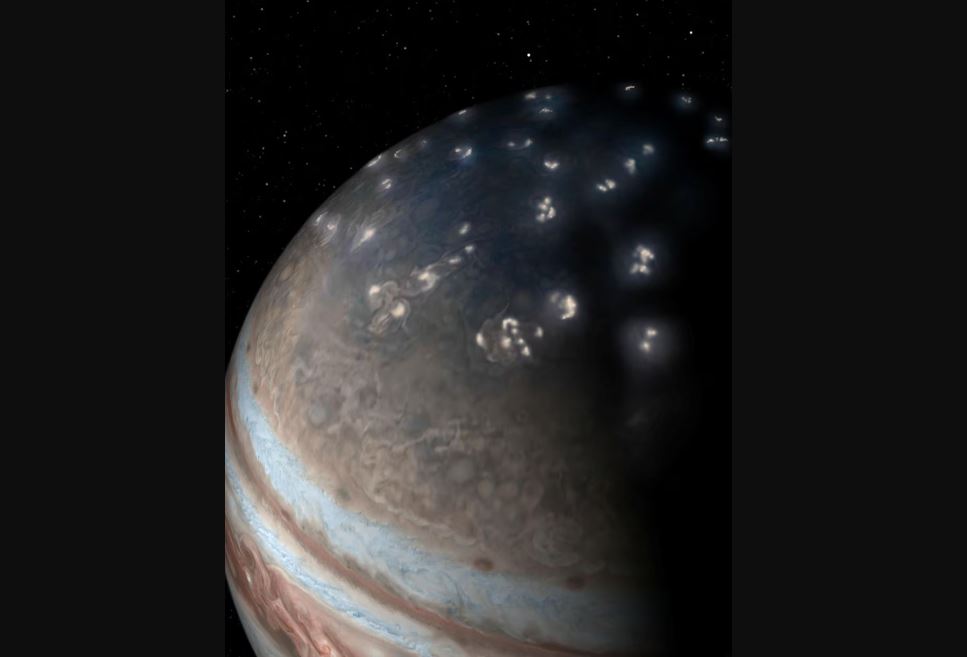NASA's Spacecraft Reveals How Jupiter's Lightning Resembles Earth's
NASA's spacecraft reveals how Jupiter's lightning resembles earth's as water clouds akin to those on Earth shows up beneath the hazy brown ammonia clouds enveloping Jupiter. In a mesmerizing display witnessed by various spacecraft, including NASA's Juno probe, lightning frequently illuminates these depths.
Author:Hajra ShannonReviewer:Paula M. GrahamMay 26, 20233.2K Shares129.8K Views

NASA's spacecraft reveals how Jupiter's lightning resembles earth'sas water clouds akin to those on Earth shows up beneath the hazy brown ammonia clouds enveloping Jupiter. In a mesmerizing display witnessed by various spacecraft, including NASA's Juno probe, lightning frequently illuminates these depths.
Scientists have gained fresh insights into the lightning processes on Jupiter through data acquired by Juno. Despite the vast disparities between the two planets, these findings reveal striking similarities between Jupiter's lightning and those occurring on Earth.
While Earth is a comparatively small, rocky world, Jupiter is an immense gas giant. Its colossal size is such that it could accommodate all other planets in our solar system with room to spare, encompassing over 1,300 Earths.
Utilizing half a decade's worth of high-resolution data collected by Juno's radio receiver during its orbit around Jupiter, scientists have made a significant discovery. They found that the initiation processes of lightning on the planet follow a rhythmic pattern reminiscent of those observed within Earth's clouds.
The flashes of lightning on Jupiter exhibited pulsations with time intervals of approximately one millisecond, mirroring the behavior of thunderstorms on our home planet. It is worth noting that lightning is the most potent naturally occurring source of electricity on Earth.
According to a statement by the planetary scientist Ivana Kolmasova of the Czech Academy of Sciences' Institute of Atmospheric Physics in Prague, lead author of the study published this week in the journal Nature Communications.
“„Lightning is an electric discharge which is initiated inside thunderclouds. The ice and water particles inside the cloud get charged by collisions and form layers of particles with the charge of the same polarity.- Ivana Kolmasova of the Czech Academy of Sciences' Institute of Atmospheric Physics in Prague
"By this process, a huge electric field is established and the discharge can be initiated. This explanation is somewhat simplified because scientists are still not completely sure what is exactly happening inside thunderclouds," Kolmasova added.
Jupiter's lightning was first confirmed in 1979 when NASA's Voyager 1 spacecraft detected distinct radio emissions at audible frequencies while journeying through the solar system. Similar to Jupiter, the gas giants Saturn, Uranus, and Neptune have also been observed to possess lightning. While there is some indication of lightning in the clouds of Venus, a rocky planet, its existence remains a subject of debate among scientists.
Further research has unveiled additional parallels in the lightning phenomena of Jupiter and Earth. Notably, the rates of lightning activity on both planets are comparable, although the distribution of lightning on Jupiter showcases variations from that observed on Earth.
"On Earth, the tropical regions are the most active ones. The majority of Jovian lightning occurs in mid-latitudes and also in polar regions. We have nearly no lightning activity close to the poles on the Earth. It means that conditions for the formation of Jovian and terrestrial thunderclouds are probably very different," Kolmasova said.
"There were some attempts to compare the power of lightning based on optical measurements and it was concluded that lightning on Jupiter might be comparable with the strongest terrestrial lightning," Kolmasova added, while noting that more analysis is planned.
Jupiter, the fifth planet from the sun, is predominantly composed of hydrogen and helium, accompanied by small amounts of other gases. With a diameter of approximately 88,850 miles (143,000 km), it exhibits a vibrant and captivating appearance characterized by its distinctive stripes and a handful of prominent storms.
Conclusion
Since 2016, the Juno spacecraft has been in orbit around Jupiter, diligently gathering valuable data pertaining to its atmosphere, internal structure, magnetic field, and the magnetic environment surrounding the planet created by its internal forces. Through its ongoing mission, Juno has significantly contributed to our understanding of this colossal gas giant.
Jump to

Hajra Shannon
Author

Paula M. Graham
Reviewer
Latest Articles
Popular Articles
